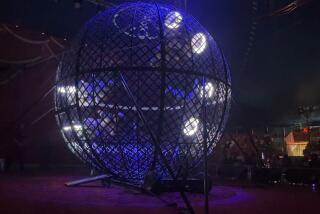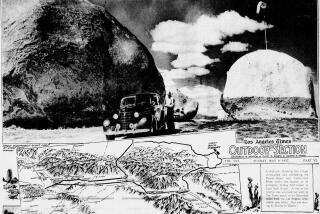A vision’s place in the sun
CALIFORNIA CITY -- — Even as the early morning chill lingered in this spot of desolate desert most frequented by dune buggies and dirt bikes, the sunlight was fierce, highlighting every shadow and making even the faintest color bright.
A string of worn flags around an altar housing a statue of the Virgin Mary stood out in the light and hinted at the festive gathering that would soon take shape.
By 7 a.m. scores of people had already arrived, carrying bottles of water, ice chests and rosaries. A few women carried roses, tulips and calla lilies and set them lovingly on the ground near the altar.
“I look forward to these days,” said Rosie Gaines, 77, a retired aircraft worker from Lancaster. “I find it emotional here.”
Gaines and nearly 1,000 others assembled last month at a barren site known as Our Lady of the Rock. On the 13th of every month, they say, the Virgin Mary appears and speaks to a woman named Maria Paula Acuna. Crowds have gathered here, about 10 miles north of California City, for nearly 20 years.
Some visitors photograph the sun, saying they see Mary in the images. Some are just curious, some seek miracles and some say they want to feel closer to God. Each 13th they create a fleeting community of faith in the desert.
Reported sightings of the Virgin Mary are widespread. Her image has been perceived in windows, gold nuggets, pieces of chocolate and, perhaps most infamously, on tortillas. In rarer instances, people say Mary speaks to them.
Scholars who have studied the phenomenon see a pattern: Publicity draws the curious and faithful, but the excitement quickly fizzles. Rarely is a lasting community forged, said Lisa Bitel, a professor of history and religion at USC who is co-writing a book on Our Lady of the Rock.
In 1990, Acuna said, she had a vision of the Virgin Mary in Lopez Canyon near her home in Pacoima. Her 3-year-old daughter, the youngest of six children, had leukemia, and the Virgin cured her, she said. Acuna returned to the site, and as word spread of her vision, bigger and bigger crowds joined her until the property owners complained, and the gathering soon moved to its current location.
On this spring day, Acuna arrived in a white van, smiling and wearing a full-length white habit. She stepped out of the van and the crowd ran to her: “My brother has cancer.” “My cousin is sick.” “Please, mother!”
Acuna smiled but kept quiet. A man in a T-shirt reading “Our Lady of the Rock” told the crowd to save their petitions for “Mother Acuna” for later. For now, just let her walk, he said.
“I believe there are people who can intercede for God or the Virgin Mary,” said Linda Mora, 60, of Montebello as she walked alongside Acuna.
There will always be naysayers who don’t believe, she said, but “if it makes people happy, if people believe, then they should just leave us alone.”
As Acuna walked down the road, followed by musicians, someone suddenly said, “She sees something.” The message rippled through the crowd. Many dropped to their knees and turned to watch Acuna, who fell to her knees and whispered words of prayer.
Acuna smiles knowingly and often. She can be friendly but doesn’t seem to posses the magnetic allure one might attribute to a telegenic preacher. She does not belong to an established religious order.
Thirteen years ago, Cardinal Roger M. Mahony of the Los Angeles Roman Catholic Archdiocese disavowed the reported apparitions, saying followers were “in danger of being misled” and that the archdiocese found doctrinal, canonical and financial irregularities among organizers of the ceremonies in the desert. The archdiocese has not changed its position on the desert gatherings.
Bitel said people who report apparitions are on the fringes of organized religion. Some of those drawn to these seers, as they are known, say they attend church regularly but are looking for a connection that eludes them inside the parish. Others have eschewed organized Christian denominations but still believe in the Virgin Mary.
Seers are often women or children, often poor or working class, Bitel said. They’re “people who are disenfranchised from the traditional leadership of the church, people who couldn’t be priests or bishops or popes but who obviously have some spiritual influence,” she said.
There have been a few similar cases around the country.
In the 1990s, hundreds of thousands flocked to the Georgia farm of housewife Nancy Fowler after she claimed to see the Virgin Mary. Fowler read messages of faith to the crowd but also predicted disasters, saying in 1993 that she had visions of Chinese soldiers occupying American soil.
Though Fowler stopped making announcements in 1998, dozens of followers still stop to pray daily at religious statues surrounding her home.
In Bayside, N.Y., Veronica Lueken said the Virgin appeared to her shortly after the assassination of Robert F. Kennedy in 1968. She led thousands of followers for more than 20 years. Even after her death in 1995, hundreds have continued gathering at a shrine known as Our Lady of the Roses, where Lueken often spoke.
Acuna, for her part, is reclusive, saying she cannot speak about her past without the permission of a “spiritual father,” whom she refuses to name. Information about her past is scarce. She was born in Sonora, Mexico, and came to the United States 38 years ago “for the same reason everyone comes, to look for a better life for my children,” she said.
Acuna says she lives in a trailer in California City, in Kern County, with four women, whom she calls “sisters,” though they do not appear to be recognized by any church. They manage a nonprofit known as the Marian Movement of Southern California that reports tens of thousands of dollars in donations every year. The group passes its days praying the rosary, making embroidered textiles for donations and preaching to inmates at the nearby jail, Acuna said.
“I am poor, but I am happy,” she said.
Like others, Acuna’s messages can tilt toward the apocalyptic. In one of her sermons a few years ago, she said the world would end in four years, Bitel said. But the majority of her followers seem not to dwell on these points.
“One feels closer to God here,” said Alberto Ramos, 51, of Los Angeles, who has been coming to the site with his four brothers for nearly a year.
“I’ve seen the body of Christ. I’ve seen angels. I’ve seen the Virgin,” Ramos said, flipping through a stack of Polaroid pictures. In one, dark rings appeared around the sun. In another, the silhouette of a woman seemed to shade the sun.
Others say they feel closer to Mary or even the Catholic Church by coming here.
Later, Acuna put her hands on every person who approached her. Erika Lopez, 25, glanced down on her daughter’s bald head briefly before handing her to Acuna, along with a quickly scribbled note: “Paulina Lopez, Bakersfield, 4 years old, kidney cancer.” Acuna smiled at the girl and prayed briefly before returning her to her mother.
A few minutes later, Cynthia Muro’s family asked Acuna to pray over the 21-year-old, who appeared to have difficulty walking and moving her arms. Acuna squeezed her hands, and asked her to lift her arms up and then out, all the while murmuring prayers.
“She needs physical therapy,” Acuna told the woman’s family. “There’s a problem with her nerves.” They smiled politely and walked away.
After Acuna made her way through the crowd, people returned to their cars, and one by one they drove off. A woman sold the flowers that adorned the altar for $5 apiece. A pair of men raffled off framed paintings of the Virgin that had been laid at a nearby cross.
The tents, umbrellas and folding chairs were packed away, and, slowly but steadily, the community that had appeared for a few hours in the desert disappeared.
--
More to Read
Sign up for The Wild
We’ll help you find the best places to hike, bike and run, as well as the perfect silent spots for meditation and yoga.
You may occasionally receive promotional content from the Los Angeles Times.







